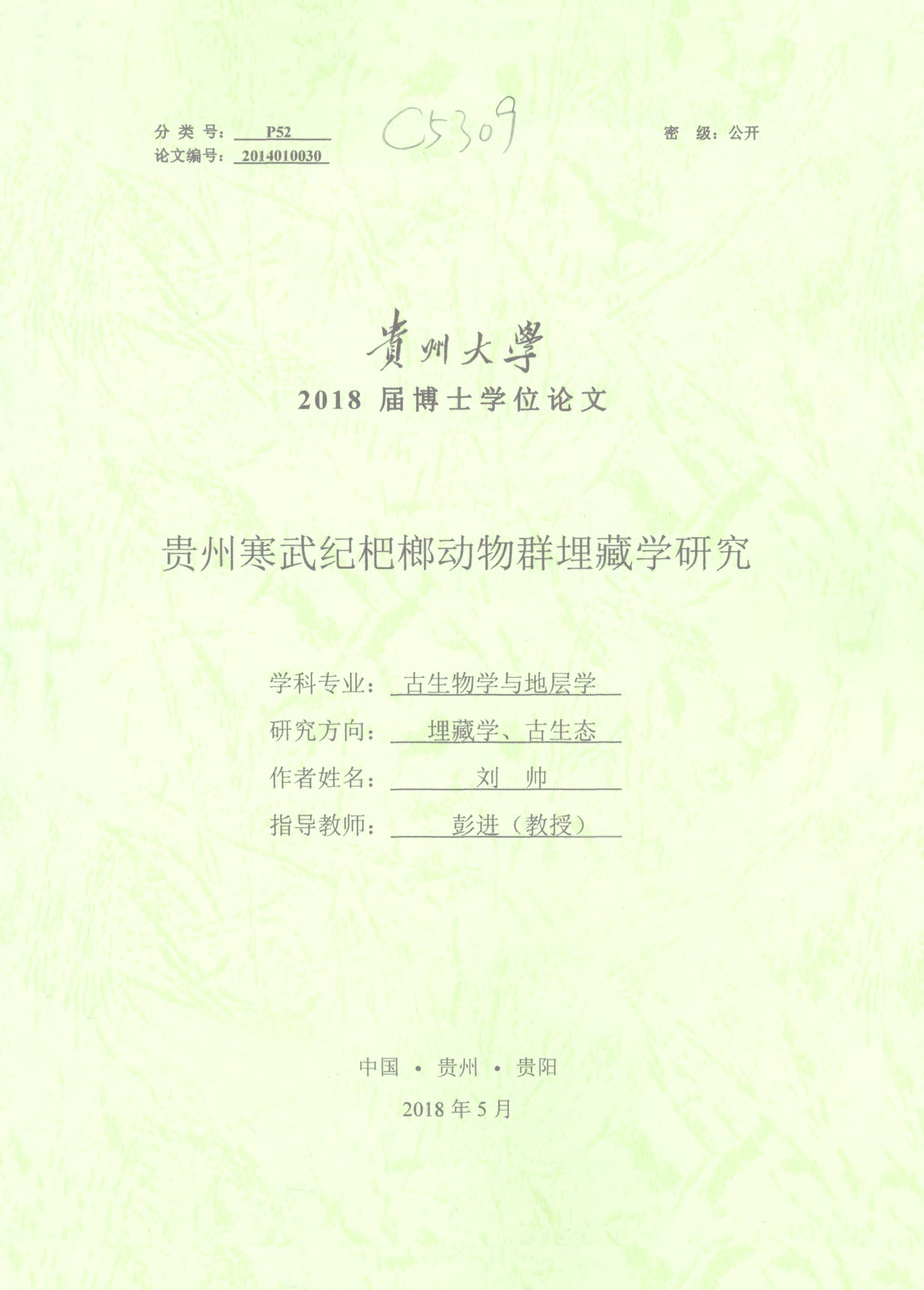| 英文摘要 |
The Balang Formation (Cambrian Series 2, Stage 4), which crop out in eastern Guizhou and western Hunan, China, yield a diverse assemblage of fossils, many of them exceptionally preserved. In terms of preservation style and diversity, fossils of the Balang Fauna are similar to fossils from the better-known Burgess Shale of British Columbia, Canada, and the Chengjiang and Kaili deposits of China. The Balang Formation was deposited in the Transitional Slope Belt of the South China Platform, and has an age intermediate between the Chengjiang and Kaili biotas. It is also older than the Burgess Shale Biota. Exceptionally preserved fossils were first recognized in the Balang Formation in 2004. Since that time, nine localities in eastern Guizhou have been identified and quarried. Most fossils preserving nonbiomineralized body parts occur in greenish to yellowish-green silty shales in the upper part of the Balang Formation. The most prolific localities are the Wenglingtang and Pusazhai sections in northwest Kaili city, the Geyi section in Taijiang city, and the Lazizhai section in Jianhe county. So far, body fossil remains of at least nine major groups of organisms have been recognized from the Balang Fauna: cyanobacteria, "algae," chancelloriids, sponges, cnidarians, "worms," brachiopods, hyoliths, arthropods and echinoderms. In addition, some trace fossils are known from the Balang Fauna. This study focuses on the taphonomy of fossils from the Lazizhai section. Fossils at this locality are both abundant and diverse. In the Laizzhai section, the Balang Formation is 192 meters thick. It is underlain by the Bianmachong Formation which is dominated by grey and black calcareous mudstone, and overlain by the Tsinghsutung (Qingxudong) Formation, which is dominated by greenish-grey, thin-bedded limestones. Here, the Balang Fauna is preserved in the middle and upper parts of the Balang Formation. Exceptionally preserved fossils occur primarily in two stratigraphic intervals. The lower one is about 2.2 meters thick, and the upper one is about 1 meter thick. The two productive stratigraphic intervals are separated by about five meters stratigraphically. The lower interval yields a diverse fossil assemblage that includes oryctocephalid trilobites (which were presumably nektonic to planktonic), nonbiomineralizing arthropods such as Naraoia, Isoxys, Tuzoia, and Leanchoilia (which were probably nektobenthic), the palaeoscolecidan "worm" Wronascolex (which was benthic, and probably infaunal), hyoliths (which were benthic), eocrinoid echinoderms (which were benthic), and sponges (which were benthic and sessile). Many of the animal skeletons are found articulated, and some retain appendages and other nonbiomineralized anatomy. Fossils are inferred to have been episodically buried under storm deposits, or storm-triggered turbidite deposits. Most biota were probably autochthonous or parauchthonous. In the upper stratigraphic interval, the fossils are less diverse than in the lower interval. They consist of a mix of articulated and disarticulated remains. Articulated trilobite exoskeletons and separated sclerites are both common. Nonbiomineralized arthropods recovered include single valves of Isoxys and Tuzoia. One articulated eocrinoid is known. Large amounts of Marpolia are present. Fossils, especially trilobites and Marpolia, are concentrated along several thin layers. Specimens are inferred to have been remained at the sediment-water interface for longer spans of time, accumulated a great deal of organisms, and allowed to undergo greater disarticulation, prior to burial, most biotic elements in the upper interval were probably autochthonous or parauchthonous. The Balang Fauna comprises a mix of organisms having benthic, nektobenthic, and nektonic to planktonic organisms. Sedimentary evidence suggests that organisms of the Balang Fauna lived along a deep shelf within the photic zone, in normally oxygenated marine water. The substrate may have been dysoxic. Animals of the Balang Fauna include carnivores (predators and scavengers) such as trilobites and other arthropods, deposit-feeders such as hyoliths, and filter-feeders such as sponges and eocrinoids. Stratigraphic evidence suggests that, at the time of deposition, the basin receiving Balang sediments deepened from the present-day north-west to south-east. Sediments of the Lazizhai section were deposited at greater depth than sediments of the Geyi section, for example. Vertically, the Balang Formation can be divided into four 4 members related with change of sedimentary resource and water-deep; which are arranged here in ascending order. Member 1: siltstones and muddy siltstones, representing a relatively deep sedimentary phase in a slope environment. Sedimentary-gravity flow deposits (perhaps storm-triggered turbidities) are present, and there are soft-sediment deformation structures. Fossils are uncommon except near the base of this sedimentary phase. Member 2: silty shales, reflecting a relatively deep sedimentary phase. Weak turbidity deposits, and perhaps other sediment-gravity flow deposits, are present. Horizontal bedding is developed, and body fossils are common. Member 3: fine silty shales in rhythmic, graded beds, representing a succession of muddy tempestites or storm-triggered turbidities. The two intervals of exceptional preservation occur within this sedimentary phase. Member 4: mixed shales and thin limestone beds, indicating a relatively shallow sedimentary sequence. Trace fossils are abundant. Keywords: Balang Fauna, Paleoecology, Taphonomy, Balang Formation, Cambrian, Guizhou, China
|

